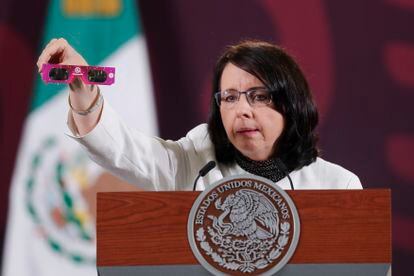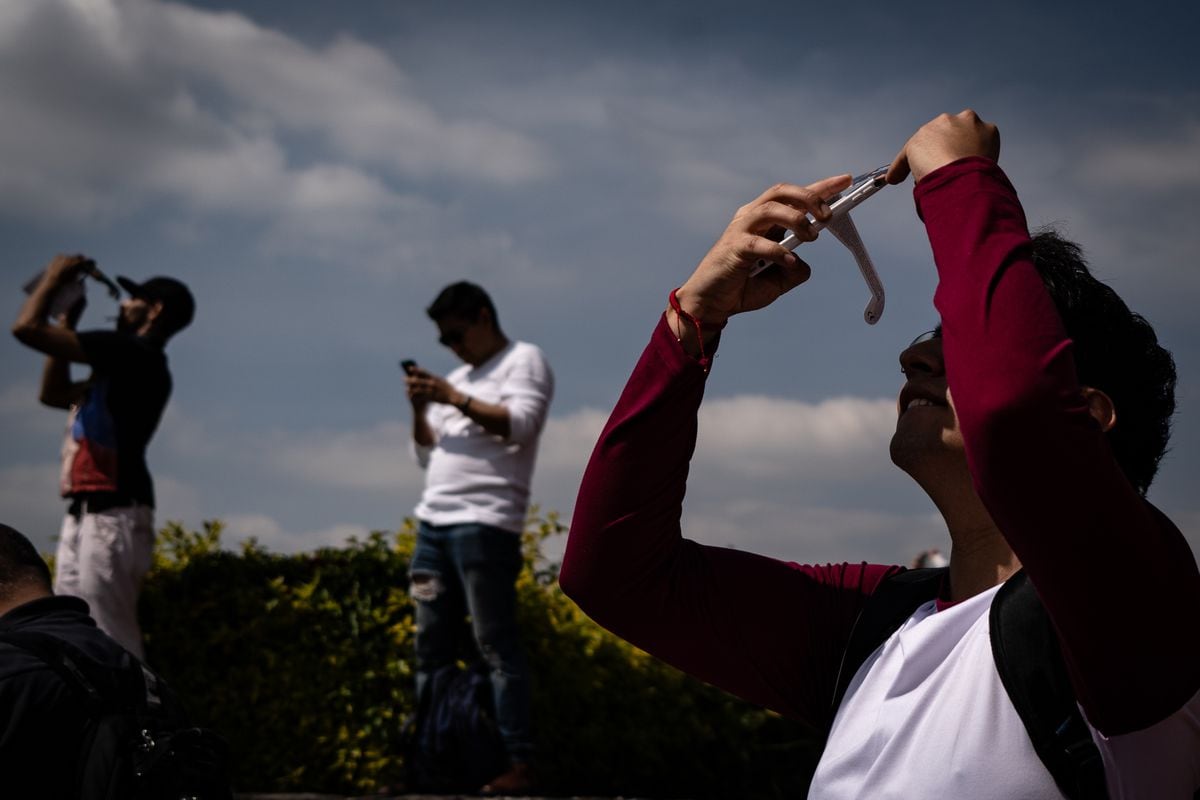On April 8, 2024, a solar eclipse will occur, an astronomical phenomenon that has not been seen in Mexico since July 1991, that is, more than 30 years ago. A total solar eclipse occurs when the Moon completely covers the solar disk and prevents the passage of sunlight towards Earth. The sky gradually darkens, the moon covers it, and the sun becomes an isolated black hole throughout the Earth. It is the astronomical phenomenon of our time: UNAM defines it as the “Great Mexican Eclipse of 2024”; However, viewing a solar eclipse directly, without approved lenses and without adequate protective measures, can cause retinal damage, and even cause permanent blindness.
What happens if you see a total solar eclipse without protection?
Watching a solar eclipse directly and without adequate protection is not safe, because it can cause eye injuries and temporary or permanent damage to the visual system. Observing without approved lenses can affect the photoreceptors in the retina, produce spots that obscure vision, generate scotomas, and even lead to complete blindness, explains Irene Ancona Duran, an ophthalmologist at the IMSS La Raza National Medical Center.
Dark glasses, camera filters, binoculars, or any telescope are not safe tools for viewing the eclipse. Its use can also cause retinal damage. In this sense, astronaut Stephen Bowen warns of the dangers of viewing the phenomenon without precautions: “Seeing any part of the sun during an eclipse without protection, even for a short time, can cause irreparable eye damage.” in Video published by NASA Where experts share tips for enjoying the solar eclipse.

How can we safely see the solar eclipse on April 8?
The safest way to view the solar eclipse on April 8 is to use approved lenses, which include filters for direct viewing of the sun, and this type of glasses must meet the conditions. International standard ISO 12312-2. “Lenses approved for viewing a solar eclipse are thousands of times darker than traditional sunglasses. “If they look like they are scratched or damaged, they should not be used,” explains engineer and NASA astronaut Warren Hoburg. You can also use shade 14 welding filters or observe indirectly Using sheets of paper or trees.These are the options for watching the solar eclipse safely:
- Lenses certified to the international standard ISO 12312-2
- Welding glass with an opacity level of 14 or more
- Viewing the eclipse's shadow indirectly
The American Astronomical Society (AAS) recommends purchasing lenses from approved suppliers. You can check out what they are below connection. According to the Autonomous Metropolitan University and the National Autonomous University of Mexico (UNAM), it is safe to use welding filters with opacity level 14 — or any higher category — to view a solar eclipse. There is another way to see it indirectly: projecting the sun's shadow with trees, paper, or using devices made of cardboard.
What not to wear to watch the solar eclipse on April 8?
Dark glasses provide no protection when viewing the eclipse. Also, water is not an element that provides a safe projection of the astronomical phenomenon for viewing it indirectly. Traditional camera lenses and telescopes are not a safe way to observe this phenomenon. UNAM provides a list that contains: Things that should not be used to view the eclipse:
- Sunglasses
- Photo cameras
- X ray
- Dark crystals
- Cons of roll photography
- CDs to see the sun's reflection
- Aluminum foil
- Water to display the image of the sun
Where can I buy glasses certified to see a total solar eclipse?
Certified lenses can be purchased from e-commerce platforms such as MercadoLibre, Amazon, etc. However, delivery times and availability may impact consumers. The National Polytechnic Institute (IPN), the National Autonomous University of Mexico (UNAM) and the Police Museum will lend, provide or sell glasses for viewing the eclipse.
In the case of the IPN, the glasses are distributed at the Tezozómoc Interactive Museum or at the Luis Enrique Erro Planetarium. Visitors must purchase an Astropass and make the trip to the cultural site to receive a pair of glasses approved as a gift. IPN will also offer it for sale to the general public at a cost of 60 Mexican pesos. 2000 copies available. Meanwhile, the National Autonomous University of Mexico will loan its visitors copies of approved lenses during the astronomical event it is organizing at Las Islas de Ciudad Universitaria. These copies are delivered to the student community, teachers and the general public.
Finally, the Mexico City Police Museum will be offering eclipse viewing glasses for sale made by Mexican inmates for 88 Mexican pesos. They are available at 136 Liverpool Street, in the Juarez neighborhood, and at Hazem Valer Prison Products StoreIt is located at San Antonio Abad No. 130, in the Mayor's Office of Cuauhtémoc, in Mexico City.
How do we protect pets during an astronomical phenomenon?
according to A study conducted by the National Center for Biotechnology Information in the United States, Total solar eclipses usually affect the behavior of animals or pets because they interfere with usual light levels and generate meteorological changes. For this reason, some recommendations for pets or companion animals during the eclipse are to keep them indoors, not expose them directly to the sun, monitor their behavior, and finally accompany them during the eclipse.
Where to see the solar eclipse on April 8? Broadcasts of NASA and its activities in Mexico
NASA and UNAM will have a live stream to watch the solar eclipse on April 8. In NASA's case, it's transmission Internet page; UNAM will do the same on Mexico's Open Television Channel 20.1 (TV UNAM) and on the YouTube channels it operates. These are the broadcasts available to watch the solar eclipse on April 8:
- a pot
- UNAM TV
- Science Distance Channel on YouTube
- YouTube channel of the Institute of Geophysics
- Facebook National Graduate School Morelia
The National Autonomous University of Mexico has certified telescopes, monitors and lenses for observing the eclipse at Las Islas de Ciudad Universitaria, in the Plaza Universum – Science Museum, in the Institute of Geophysics, in the Geophysics Museum, in the Escuela National of Mexico. Postgraduate Studies (ENES) Juriquilla, at the Museo de la Luz Mérida, at ENES Morelos and at ENES Morelia.
Subscribe to the EL PAÍS Mexico newsletter And for WhatsApp channel And get all the basic information about the current events in this country.

“Proud web fanatic. Subtly charming twitter geek. Reader. Internet trailblazer. Music buff.”

:quality(85)/cloudfront-us-east-1.images.arcpublishing.com/infobae/TEQF6EONZRFGLLLDIDD4L2O4EE.jpg)

:quality(75)/cloudfront-us-east-1.images.arcpublishing.com/elcomercio/XU32LRAEZFDDPNVHLFU3CKVBYY.jpg)



More Stories
How to create 3D videos with my iPhone, it will be very useful even for your business
NASA discovers an anomaly in the Earth’s magnetic field that could have serious consequences for humans
Can the Earth be divided into two parts?